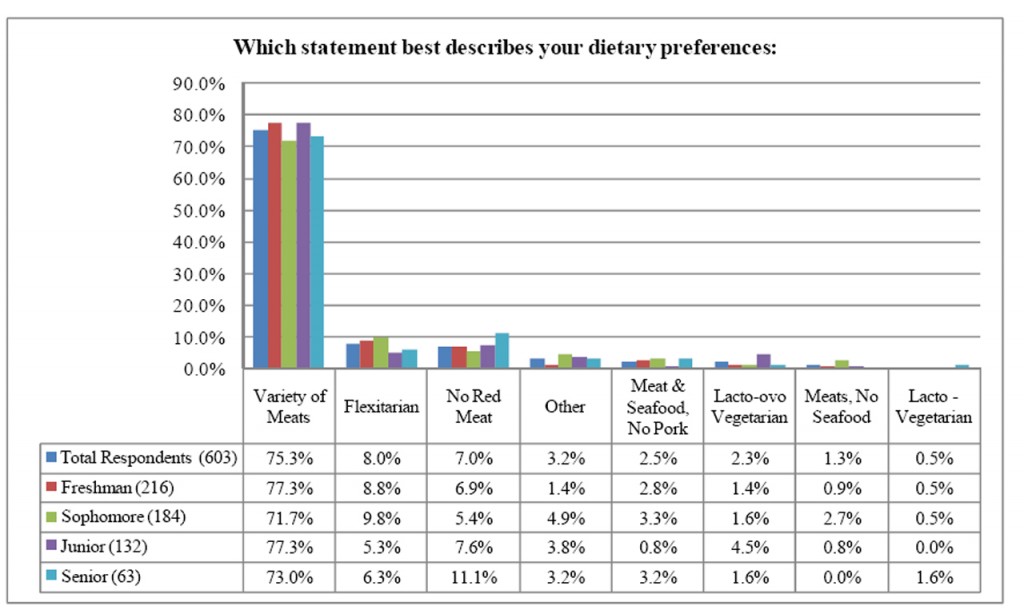
Senior Adele Young sat sipping her drink as her friends dug into their Applebee’s half-priced appetizers. As chips dove into her favorite appetizer, spinach and artichoke dip, Adele nibbled her no-name, horrible tasting allergen free power bar. The smell of the warm foods wafted through the air, and she looked on enviously, realizing the white rice and tuna leftovers she ate before going out for her 22nd birthday dinner were not comparable.
“I normally don’t miss normal food much,” Young said. “They tasted good, but I remember how it made me feel. Yeah, I’ll skip that feeling.”
In December, Young discovered that the reason food felt “like it turned into a rock” in her stomach was that she has food allergies – a lot of them. After four rounds of testing, the doctors concluded that wheat, eggs, milk, corn, peanuts, chicken, pork and beef cannot touch her plate, and pesticides and grass complicate the fresh foods she can eat.
“I always felt sick when I ate,” Young said. “I thought that was normal. Then, as I started talking to people about it, I started learning that’s not normal.”
Young is one of many students that have a limited diet at Concordia. Each spring, Dining Services administers a survey to gain an idea of how many students they have with special eating preferences, such as vegetarian or vegan. Of the 603 respondents last year, 24.7 percent said they had specific limitations, due to preference or allergies.
After years of thinking throwing up once a day and needing—not wanting—to fall asleep after a meal happened to everyone, she wanted answers. In December 2011, she tried cutting soy out of her diet because of its prevalence in a wide variety of foods. She didn’t feel better.
She then went to Catalyst Medical Center in Fargo for allergy and food intolerance testing.
“I’m not sure how I’m going to survive without my mom’s tater-tot hotdish,” she said. “It’s my comfort food.”
“It looked like I had 40 mosquito bites on my arms,” Young said, recalling what her arm looked like after testing positive to everything except cats, dogs, cows, horses and one form of fungus.
Now her diet consists of “rice everything,” in addition to organic fruits and vegetables—she’s allergic to pesticides —fish and beans. She spends more than four hours every day preparing food that will not make her feel ill.
“Finding out I had an intolerance to beef and pork was the hardest diagnosis for me because it felt like a piece of my identity was taken from me, and I was given a new one I didn’t want,” Young said. “I went from a good Midwestern-raised girl who ate the deer her uncles shot to the vegan who people think is just prissy.”
Not only does she no longer work in Dining Services (she had to quit after a pesticide-covered melon made her break out in hives), but she no longer eats there either. While she said there are many options for students who have intolerance to one or two food items, she believes there is no safe way to eat in DS with her amount of limitations.
Of the 24.7 percent of students with special dietary restrictions, they can be broken down into flexitarians, lacto-ovo vegetarians, lacto-vegetarians and students that eat no red meat, no pork and no seafood.
“If a student has a food limitation, we meet with them and get them more information about the food we serve and ways they can expand their options,” said Carrie Holgeson, the residential dining manager of Dining Services.
Gluten intolerance is a growing limitation for Concordia students, Holgeson said, attributing the growth partially to advances in testing for the allergy and partially to it being a health fad. Veganism and vegetarianism have always had a strong presence on campus, she added.
“Cobber students seem to want to eat healthier and more sustainably,” Holgeson said, though she added that the foods that are higher in fat and sodium are still the most popular choices offered at DS. “Healthy food consumption is fairly significantly lower.”
Heather Stueven, one of the five registered nutritionists on the DS staff, says she meets with approximately 20 students each year to discuss foods they can eat with certain nutritional limitations. Between individual counseling and the Net Nutrition and Mission Nutrition programs, which most vegetarians utilize to make their food selections, Stueven and Holgeson both believe DS meets the needs of all of the students who ask for help making their dining selections.
“I think that a lot more students are seeking out assistance to ensure they are indulging in the foods that fit their particular diet or intolerance,” Stueven said in an email March 29.
Holgeson said that in the 11 years she has been at Concordia, there have only been two “extreme” instances that she can recall where Dining Services was unable to meet the dietary needs of students.
“Dining services is committed to meeting every nutritional need a student has, and we will come up with any way to meet a student’s specific needs,” Holgeson said. “We want to support the community atmosphere of Concordia, and part of that is eating and talking together in Anderson Commons.”
While Holgeson said it was unfortunate to hear there was some student displeasure with their DS experience, she said this most often occurs when students don’t take the initiative to ask for help.
“We want to help them and make sure they have good nutrition,” Holgeson said.
Young, however, decided DS would not be a viable option for her.
“I don’t blame DS for not being able to eat there anymore,” she said. “It’s just the nature of the beas—they try their best to avoid cross-contamination and make meals that work for everyone, but it just wasn’t enough for me.”
Young canceled her meal plan soon after finding out about her allergies because of the limited vegan and vegetarian options available. Though DS claims that 10 percent of the meals they provide are vegetarian, she had enough after weeks of eating meals of spinach and olive oil.
“For the price DS charges, it’s unrealistic for me to have so few options,” Young said. “Sometimes, chickpeas and raw veggies just don’t cut it. There’s always salad, but paying for $10 for a salad is dumb.”
She has qualms about nearly all items in DS, as most containers are sprayed with Pam to avoid a mess (which she is allergic to), vegetables often aren’t organic and fruit is limited.
“I can’t let other people cook my food—every time I do, I get sick. There is no way to ensure that my food doesn’t contain something that will hurt me,” she said.
Young suggests that DS invest in an all-veggie section that is labeled an animal-free zone, and that rice, canola or olive oil be used instead of other non-stick sprays. She also feels sympathy for students with dietary restrictions living in dorms, as she lives in Boggs and has the luxury of a kitchen so she can prepare her own meals.
“If you have these dietary concerns, you shouldn’t be asked to endanger yourselves by leaving your food in such a contaminable area,” Young said.
Though she says Dining Services tried to work with her to create a meal plan that worked for her, she ended up only using 25 percent of the meals she had last semester, if that.
“It’s not fair, to be honest,” Young said. “I was pressured into having a meal plan. They told me it would be okay, but it wasn’t okay.”
Young is thankful that her family is able to help her make sure her bills are paid, because paying for whole food is expensive—upwards of $400 each month. While she says she doesn’t miss normal food most of the time, her birthday was one exception. Her mom’s food is the other.


